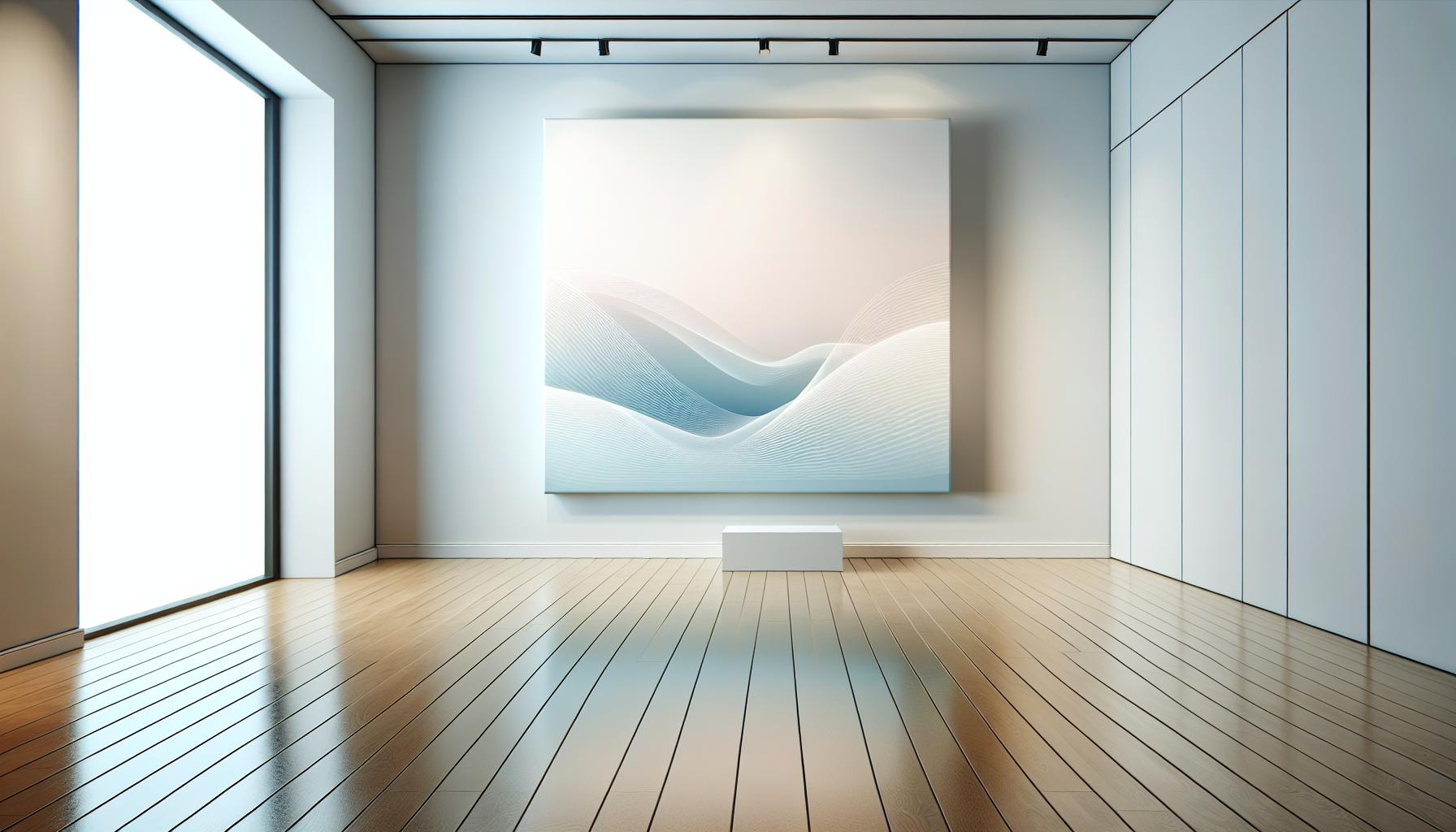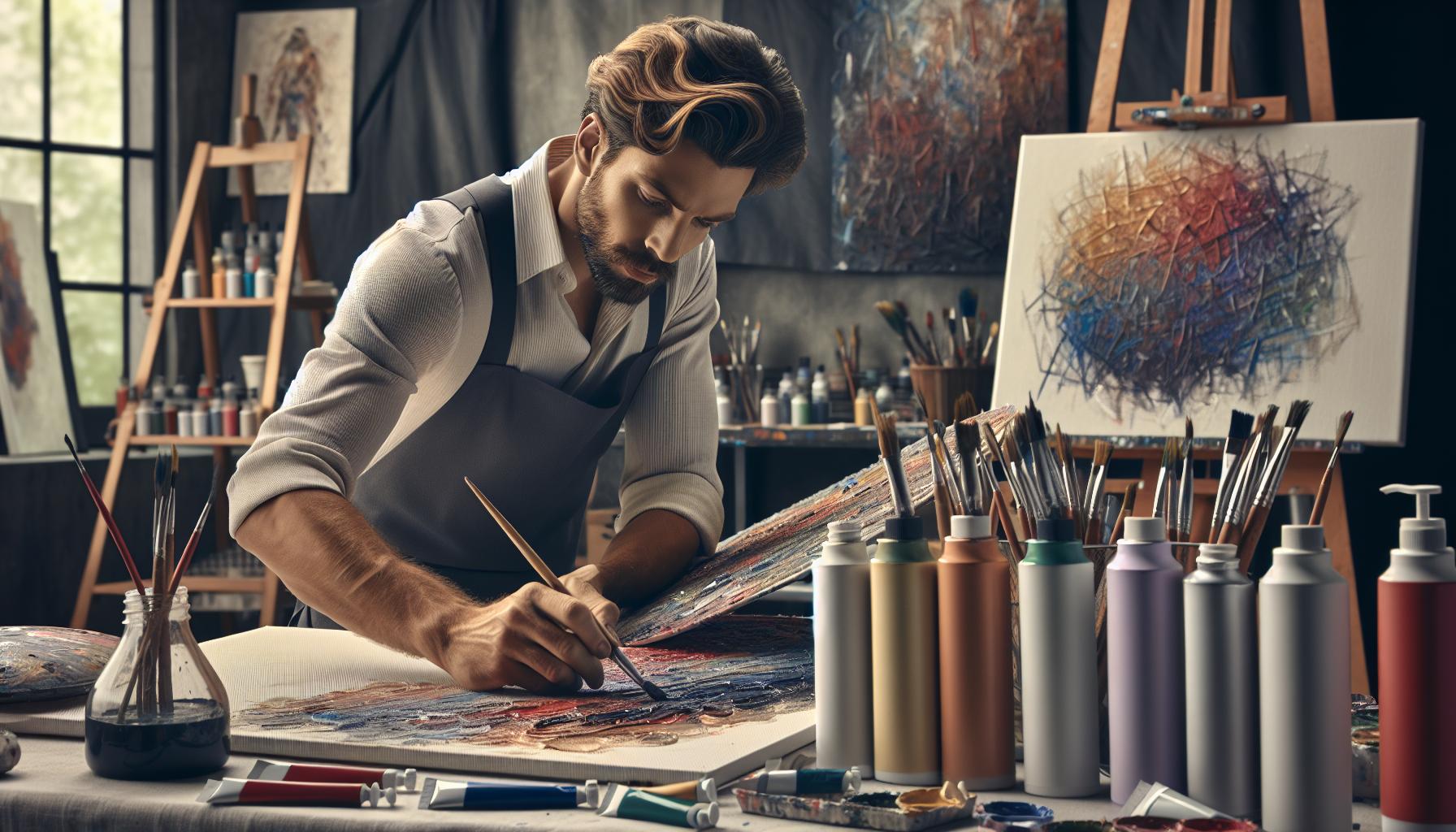Modern abstract canvas art transforms ordinary spaces into vibrant galleries where imagination runs wild. With bold strokes splashed across pristine canvases these contemporary masterpieces spark conversations and ignite emotions in ways traditional art never could.
In today’s design-conscious world abstract art has evolved from its rebellious roots into a sophisticated statement of personal style. Whether it’s geometric shapes dancing across the canvas or explosive color combinations that defy convention modern abstract pieces have become the go-to choice for interior designers and art enthusiasts alike. The beauty lies in its versatility – there’s no right or wrong way to interpret these dynamic creations that speak differently to each observer.
Modern Abstract Canvas Art
Modern abstract canvas art expresses non-representational forms through bold colors, geometric shapes or organic patterns on canvas surfaces. This artistic style breaks from traditional realistic depictions to explore emotion, movement and conceptual ideas.
Key Characteristics and Elements
Abstract canvas art incorporates fundamental design elements of line, shape, color and texture to create visual impact. Gestural brushstrokes convey dynamic energy while minimalist compositions focus on essential forms. Color relationships play a crucial role through contrasting hues, monochromatic schemes or vivid palettes that evoke specific moods. Layered techniques add depth through overlapping elements, translucent effects and varied paint applications. Asymmetrical balance, rhythmic repetition and negative space create visual tension and harmony across the canvas surface.
Influence of Contemporary Culture
Digital aesthetics shape modern abstract art through pixelated forms, glitch effects and screen-inspired color palettes. Social media’s visual culture influences composition styles with Instagram-friendly formats and bold graphic elements. Urban environments inspire geometric abstractions reflecting architectural lines and city grids. Global artistic exchanges merge diverse cultural symbols into contemporary abstract expressions. Technology’s impact appears in precise edges, digital printing techniques and mixed media incorporating modern materials.
Popular Styles in Modern Abstract Canvas Art

Modern abstract canvas art encompasses diverse stylistic approaches that reflect contemporary artistic sensibilities. Leading galleries feature three prominent styles that dominate current abstract art collections.
Minimalist Abstraction
Minimalist abstraction focuses on essential elements through simplified compositions. Artists employ limited color palettes, often selecting monochromatic schemes or contrasting tones to create visual impact. Key features include negative space utilization, clean lines, single focal points. Recent exhibitions showcase pieces with subtle tonal variations, soft gradients, restrained brushwork. Notable artists like Agnes Martin demonstrate masterful use of grid systems, horizontal lines, methodical compositions to achieve meditative qualities in their work.
Geometric Patterns
Geometric patterns combine precise mathematical forms with artistic expression in modern abstract art. Artists integrate circles, triangles, squares, polygons to create dynamic compositions. Contemporary geometric abstractions feature overlapping shapes, repeated motifs, calculated color relationships. Digital tools enable artists to create complex pattern arrangements while maintaining hand-painted authenticity. Popular techniques include hard-edge painting, optical illusions, layered transparent forms.
Expressionist Techniques
Expressionist techniques emphasize spontaneous mark-making through intuitive gestures. Artists apply bold brushstrokes, drips, splatters to convey emotional energy. Common elements include textural variations, impasto techniques, unconventional tool usage. Contemporary expressionist works incorporate mixed media elements, experimental surfaces, innovative paint applications. Galleries report increased interest in pieces featuring dynamic movement, raw emotional content, visible artistic processes.
Materials and Techniques

Modern abstract canvas art combines traditional art materials with innovative techniques to create distinctive contemporary expressions. Artists select specific materials to achieve unique textures, depths, and visual effects in their abstract compositions.
Contemporary Canvas Preparations
Contemporary artists prepare canvases using advanced priming methods to enhance paint adhesion and longevity. Professional-grade cotton duck canvas offers optimal texture control through multiple gesso applications in varying densities. Artists apply specialized primers to create unique surface characteristics: smooth surfaces for precise geometric patterns, textured grounds for expressive brushwork, or absorbent layers for fluid painting techniques. Modern preparation methods incorporate synthetic materials like polymer-based primers that provide enhanced durability and UV protection. Professional artists stretch canvases over reinforced stretcher bars using pneumatic tools to achieve precise tension levels.
Innovative Paint Applications
Modern abstract artists employ diverse paint application methods to achieve distinctive effects. Fluid acrylic pouring creates organic patterns through controlled paint mixing with silicone oils and specialized mediums. Artists layer translucent glazes using high-flow acrylics to build depth and luminosity in abstract compositions. Contemporary techniques include:
- Digital projections guide precise geometric pattern applications
- Spray atomizers create gradient effects with liquid paint
- Palette knives spread thick impasto textures in bold patterns
- Silicon tools drag paint into cellular formations
- Resin pours seal artwork while adding dimensional depth
Paint manufacturers develop specialized formulas for modern application methods, including highly pigmented acrylics, metallics, and interference colors that shift appearance based on viewing angle.
Notable Modern Abstract Artists

Modern abstract canvas art continues to evolve through the contributions of innovative artists who push creative boundaries. Contemporary artists blend traditional techniques with digital innovations to create distinctive abstract expressions.
Rising Stars in Abstract Art
Petra Cortright transforms digital elements into vibrant abstract compositions using digital brushstrokes combined with traditional painting techniques. Flora Yukhnovich reinterprets classical art through abstract expressions featuring soft pastels paired with dynamic gestures. Loie Hollowell creates three-dimensional abstract paintings that explore sacred geometry through light gradients. Angel Otero develops unique abstract compositions by manipulating oil paint skins onto canvas surfaces. Tschabalala Self incorporates textile elements into abstract figurative works examining contemporary identity.
Influential Contemporary Painters
Julie Mehretu leads contemporary abstraction with large-scale canvases featuring complex layered compositions inspired by urban landscapes. Mark Bradford creates powerful abstract works using found materials like billboard paper to explore social issues. Adrian Ghenie combines abstract elements with figurative fragments using unconventional painting tools. Katharina Grosse transforms spaces through immersive abstract installations using vibrant spray-painted compositions. Peter Halley continues to influence abstract art through his geometric “cells” paintings incorporating industrial materials like Roll-a-Tex.
Collecting and Displaying Abstract Canvas Art
Modern abstract canvas art transforms spaces through thoughtful selection and strategic placement. Creating a curated collection requires understanding both artistic elements and display principles.
Choosing the Right Piece
Selecting abstract canvas art starts with evaluating the color palette compatibility with existing decor. Measure wall dimensions to determine appropriate canvas sizes: large pieces (48+ inches) create focal points while smaller works (24-36 inches) integrate into intimate spaces. Consider these key factors:
- Scale relationship between artwork size and room dimensions
- Color harmony with existing furnishings and wall colors
- Texture variations that add depth to the space
- Artwork orientation (horizontal vs vertical) based on wall layout
- Investment potential based on artist recognition and technique quality
- Natural light sources influence color perception throughout the day
- Track lighting creates focused illumination on specific elements
- 3-6 feet viewing distance maintains visual clarity
- Gallery walls group multiple pieces with 2-3 inch spacing
- Avoid direct sunlight exposure to prevent color fading
- Balance negative space around artwork for visual breathing room
Impact on Contemporary Interior Design
Modern abstract canvas art transforms contemporary interiors through strategic placement and intentional design integration. Large-scale abstract pieces create dramatic focal points in minimalist spaces, drawing attention while maintaining visual balance. Statement pieces in bold colors energize neutral rooms by introducing dynamic elements that spark visual interest.
Architectural features gain enhanced definition through carefully positioned abstract artworks. Multi-panel installations complement open floor plans, creating visual continuity across expansive walls. Monochromatic abstract pieces establish sophisticated atmospheres in corporate settings while adding textural depth.
Here’s how abstract canvas art influences different interior spaces:
- Living Areas: Oversized abstracts anchor seating arrangements creating conversation focal points
- Dining Rooms: Vertical compositions add height perception enhancing spatial dynamics
- Offices: Color-field paintings reduce visual noise promoting focus concentration
- Lobbies: Large-format pieces establish brand identity through artistic expression
Key placement considerations include:
| Factor | Impact | Application |
|---|---|---|
| Scale | Visual Weight | 60-75% of wall width |
| Height | Viewing Angle | 57-63 inches at center |
| Lighting | Color Vibrancy | 50-75 foot-candles |
| Distance | Visual Impact | 2-3x artwork width |
Abstract art integrates seamlessly with diverse design styles:
- Modern: Geometric abstracts complement clean lines
- Industrial: Textured pieces add organic elements
- Scandinavian: Minimalist compositions enhance simplicity
- Eclectic: Bold abstracts unify varied decor elements
Designers incorporate abstract canvas art to define zones in open-concept spaces creating visual boundaries without physical barriers. Custom-commissioned pieces address specific spatial challenges while maintaining aesthetic cohesion throughout interiors.
Modern abstract canvas art stands as a powerful force in contemporary interior design and artistic expression. Today’s artists continue to push boundaries by blending traditional techniques with digital innovations creating works that resonate with modern audiences.
The versatility of abstract art allows it to enhance any space while its emotional impact creates meaningful connections between viewers and artwork. As this art form evolves it reflects our changing world through bold expressions geometric precision and innovative techniques.
Whether displayed in homes galleries or public spaces modern abstract canvas art remains a dynamic medium that shapes our visual culture and enriches our everyday environments. Its lasting influence on contemporary aesthetics proves that abstract art isn’t just a trend – it’s an essential element of modern artistic expression.



